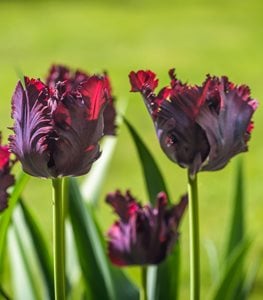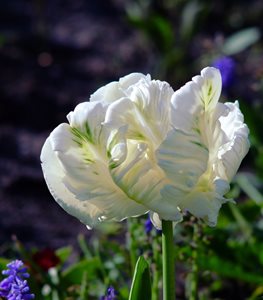Parrot Tulips - Growing Tips & Why We Love Them
These flamboyant perennials put on an impressive show in late springDespite the name, the parrot tulip is no floral copycat. With its feathery petals and dazzling colors, the parrot tulip speaks a language all its own, boldly proclaiming its individuality from the standard tulip. In fact, parrot tulips are often mistaken for peonies because of their large cup-shaped blooms and ruffled edges. Most varieties are bi-colored, and some also have a delicate fragrance.
REASONS TO LOVE THEM
- Parrot tulips open their ruffled petals in mid to late spring after most other tulips have bloomed and faded, extending the color show.
- Their huge blooms span up to 5 inches across, with streaks of color shooting through the petals like brilliant flames.
- Tall, elegant stems give parrot tulips a statuesque posture that make them a standout in the garden and a striking addition to floral arrangements.
- Parrot tulips are available in more than 50 varieties, most of which are multi-colored. Some of the shades are revealed gradually, as the blooms fully open.
THE BASICS
Zones:
4-7
Height:
12 to 26 inches tall
Exposure:
Full sun, sheltered from wind
Bloom Time:
Mid to late spring
Soil:
Well-drained
WHERE TO PLANT THEM
Parrot tulips fill the spring garden with showy texture and color, especially when used in the border or planted in groups. Plant parrot tulip bulbs in the fall in a sheltered spot, away from high winds and extreme temperatures. The bulbs can also be planted outdoors in containers or forced in pots indoors for winter blooming.
GROWING TIPS
Despite their opulent appearance, parrot tulips aren’t overly fussy in their care requirements. However, they do need a bit more attention than standard tulips to protect their frilly blooms from windstorms and heavy rain. Plant the bulbs 5 inches deep and at least 3 inches apart from late September through early November, then cover the site with a thick layer of organic mulch to protect the dormant bulbs during the winter. In early spring, remove the mulch before new growth begins. After the flowers have faded, do not remove the foliage until it has yellowed and died back. To ensure repeat blooming the following spring, feed regularly during the growing season using a balanced fertilizer.
SHOWSTOPPING VARIETIES FOR RESIDENTIAL GARDENS
'BLACK PARROT'
‘Black Parrot’ is a true showstopper, with fringed petals in deep purple and black. The sturdy stems of these flowers make them well-suited for cutting.
'APRICOT PARROT'
‘Apricot Parrot’ has large pale-apricot petals tinged creamy white and rose.
‘ESTELLA RIJNVELD'
‘Estella Rijnveld’ has flashy streaks of red running through white curled and feathered petals.
‘GREEN WAVE’
‘Green Wave' opens with bright green petals that slowly reveal soft-pink edges.
'WHITE PARROT'
‘White Parrot’ has ivory-white ruffled blooms feathered in pale green.

With their tall, elegant stems parrot tulips are a standout in the perennial garden and pair well with hostas and other groundcovers. Photo by: Susan A. Roth.
Related:
Tulip Planting Guide
Planting and Storing Flower Bulbs










